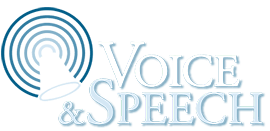Transcript
One of my favorite voice exercises is known as “the lip flutter.” It’s also known as a “lip trill,” a “lip roll,” or even “lip bubbling.” This voice exercise might be a bit difficult at first for some people, but it’s well worth the effort required to master it, and in fact, I have never found a really good substitute for the lip flutter. Any good program of voice exercises has to address relaxation, breathing, and resonance. The lip flutter is a great voice exercise to have in your toolbox because it encourages lip relaxation, probably jaw and tongue relaxation as well, breathing, and even resonance. Much like the spinal roll featured in an earlier video, it’s a wonderfully well-rounded voice exercise. In fact, it’s often while doing lip flutters that I notice my students start to connect with their whole voice. You’d be surprised at how much you tend to hold back when you speak. Here’s proof. Take a deep breath and say four to six words out loud such as, “Hi there, how are you?” and notice how much breath you have left at the end. Why didn’t you use all your breath? Isn’t it odd that in the very act of reaching out to make a connection, you unconsciously hold something back? You probably aren’t aware of it, but those old habits are always there, undermining your intention when you want to have an impact.
Lip fluttering is one of the best voice exercises for exploring the feeling of generously giving away your breath and your voice. It’s difficult to describe how it’s done, so I’ll just show you, [flutter]. It’s almost impossible to flutter your lips and hold back at the same time. You’ve got to go for it. You’ve got to put your breath out there generously and allow the fluttering to happen. It’s a very tangible, physical way to explore the feeling of being fully engaged and available whenever you use your voice. When that’s easy and comfortable with no sense of pushing or forcing, add voice to the lip flutter, [flutter]. Are you giving away your breath as generously on the voice flutter as you were on the flutter with just breath? When that’s going well, seamlessly transition from a voiced lip flutter into a vowel sound, [flutter]. Make sure there is no break between the vowel sound and the lip flutter. Does the vowel sound feel just as free and engaged as the flutter? Then try fluttering your lips and merging into a simple word with the same easy, generous feeling throughout, [flutter].
It’s probably best to use words that start with a vowel sound such as “away,” or “own,” or perhaps words that start with “h” sounds such as “hello,” or, “highway.” Good voice exercises should help you feel generous and open when you speak with the sense of no hiding—you can have it all. You can’t control how your listeners respond. You only control what you put out there in the room. So don’t fail to have an impact because you didn’t give them everything. When you use only part of your voice, then they get only part of you. That doesn’t elicit responsiveness. By practicing voice exercises that encourage you to spend your breath generously allowing it to pour out of you as you speak, you engage your whole voice and that tends to engage your whole being. Being fully in the game you’re much more likely to have an impact. For more examples of voice exercises for speaking, click the link below and download the free booklet and video series The Sound of Success.
Voice Exercises: The Lip Flutter
One of my favorite voice exercises is called the lip flutter. It’s a wonderfully well-rounded voice exercise, effecting relaxation, breathing and resonance. Voice exercises such as the lip flutter teach you to use your breath generously when you speak, engaging your whole voice and making you much more likely to have an impact.


